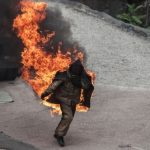 Movies and TV
Movies and TV  Movies and TV
Movies and TV  History
History 10 Things You Didn’t Know About the American National Anthem
 Technology
Technology Top 10 Everyday Tech Buzzwords That Hide a Darker Past
 Humans
Humans 10 Everyday Human Behaviors That Are Actually Survival Instincts
 Animals
Animals 10 Animals That Humiliated and Harmed Historical Leaders
 History
History 10 Most Influential Protests in Modern History
 Creepy
Creepy 10 More Representations of Death from Myth, Legend, and Folktale
 Technology
Technology 10 Scientific Breakthroughs of 2025 That’ll Change Everything
 Our World
Our World 10 Ways Icelandic Culture Makes Other Countries Look Boring
 Misconceptions
Misconceptions 10 Common Misconceptions About the Victorian Era
 Movies and TV
Movies and TV The 10 Coolest Stars to Set Sail on The Love Boat
 History
History 10 Things You Didn’t Know About the American National Anthem
 Technology
Technology Top 10 Everyday Tech Buzzwords That Hide a Darker Past
Who's Behind Listverse?

Jamie Frater
Head Editor
Jamie founded Listverse due to an insatiable desire to share fascinating, obscure, and bizarre facts. He has been a guest speaker on numerous national radio and television stations and is a five time published author.
More About Us Humans
Humans 10 Everyday Human Behaviors That Are Actually Survival Instincts
 Animals
Animals 10 Animals That Humiliated and Harmed Historical Leaders
 History
History 10 Most Influential Protests in Modern History
 Creepy
Creepy 10 More Representations of Death from Myth, Legend, and Folktale
 Technology
Technology 10 Scientific Breakthroughs of 2025 That’ll Change Everything
 Our World
Our World 10 Ways Icelandic Culture Makes Other Countries Look Boring
 Misconceptions
Misconceptions 10 Common Misconceptions About the Victorian Era
10 Major Movies That Filmed Without a Script
Filmmaking is big money, but studios and financiers can get so caught up in a concept, a director, an actor, or dreams of a big payday they forget about the nuts-n-bolts of the operation. Indeed, once the other parts are in place, it’s not uncommon for the writing to be the last thing that gets looked at, with half-formed, unfinished, and even non-existent scripts being the standard for big-budget productions. While they still came out on top financially, here are 10 serious films Hollywood let proceed without a finished draft.
Related: 10 Franchise Movies That Needed a Different Director
10 Jaws (1975)
Jaws made cinema history back in the ’70s by taking an inexperienced director, an initially mid-range budget, and a series of on-set mishaps and turning them into box office gold, all while creating the prototype for the modern summer blockbuster. So successful was Steven Spielberg’s shark-based horror thriller that the film is still regarded as one of the most influential pieces of filmmaking in existence today, regularly ranking on Top 100 lists around the globe.
Yet the whole thing was filmed like a very expensive student project, with basically no script and no clear idea of what it was supposed to be, all while shooting out on the real ocean.
According to Richard Dreyfuss (who stars as oceanographer Matt Hooper), the film went into production without a script, a cast, or a functioning shark—the supposed villain of the piece. It was only thanks to Steven Spielberg’s creativity and technical ingenuity—and the financing available to take the picture some $10 million over budget—that they managed to pull the whole thing off.[1]
9 Boyhood (2014)
Director Richard Linklater has never been one to take the easy route, constantly switching genres, trying new techniques, and generally coming out on top. So when it came to making Boyhood, a film set and shot across 12 years, he leaped at the opportunity.
Linklater used Boyhood to chart adolescence in its entirety, dropping in to film with child star Ellar Coltrane once every year for the whole 12 years. Such is the freewheeling nature of the whole affair; the director let the drama unfold in response to where his actors were in their lives, progressing with only a general idea of the structure—an approach that meant there was no script to work from.
In Linklater’s own words, he worked by “collaborating with Ethan [Hawke] with Patricia [Arquette] and the kids [Coltrane, alongside Linklater’s daughter Lorelei], who, as they matured, they become [sic] even more collaborative.” The resulting film is a labor of love that, despite its seemingly niche indie appeal, managed to make more than ten times its budget back at the box office.[2]
8 Alien 3 (1992)
The Alien franchise is still going strong 45 years after Ridley Scott’s original deep-space horror, but that doesn’t mean it’s been smooth sailing along the way. In the early ’90s, following the success of James Cameron-directed sequel Aliens, producers David Giler and Walter Hill sought to capitalize on the films’ sustained popularity with Alien 3.
After a tumultuous pre-production, which saw scripts and directors come and go, with $7 million spent before a single reel had been filmed, the studio—20th Century Fox—decided to draft in new guy David Fincher. Hoping to control the rookie director and keep spiraling costs to a minimum, they micromanaged every detail, with only one problem: There was no script.
The chaos that preceded Fincher’s arrival had resulted in a mishmash of unfinished drafts of several different scripts, which they pushed ahead with anyway. This ultimately led to the infamous breakdown between the director, producers, and the studio. Despite the divisive end-product that is Alien 3, the film did well enough to keep the series buoyant and paved the way for some of the more compelling films we have enjoyed since.[3]
7 Men in Black 3 (2012)
Men in Black fans had to wait an entire decade to see Agents J (Will Smith) and K (Tommy Lee Jones) again after the second film in the franchise had a tempestuous production and was panned by critics. However, a third installment was announced in 2009, Smith and Jones came on board, and the new film seemed to promise good times ahead.
Sony plowed into the shooting of Men in Black 3 in November 2010 because the film’s key players—including stars Smith and Jones and director Barry Sonnenfeld—were untethered from other projects, and a delay could have jeopardized their availability. Plus, there was a big tax break from New York State if they got production underway immediately. However, this meant quite literally filming without a plot.
With only one act of the film on paper, the production steamed ahead despite producers, screenwriters, and onscreen talent fighting over which direction to take it in. It should come as no surprise then that, when it finally came lumbering over the finish line, MIB 3 had run up a production bill somewhere in the region of $220 million.[4]
6 Jurassic Park III (2001)
Until 2022’s Jurassic World: Dominion, Jurassic Park III was regarded as the low point of the Jurassic film series. The first film not based on Michael Crichton’s novels, III had to stand on its own clawed feet while attracting the same numbers as its predecessors—a tall order considering it had only one member of the original cast in a starring role (Sam Neill), no Steven Spielberg and, well, no script.
There were originally two finished versions of the script that director Joe Johnston and an array of writers wrote, storyboarded, and scheduled, but which were ultimately abandoned before shooting began. Working as they went, Johnston and the cast were given pages to work from on the day of shooting, with no preparation time and no idea of the sequences or characters’ overall trajectory.
This meant they couldn’t shoot later and earlier scenes back-to-back where they were set in the same location, adding additional costs to the movie as the crew moved between Hollywood soundstages and filming locations in Hawaii. Nevertheless, Johnston put his all into a film that, in his words, “did not have a final script until after we wrapped the movie.”[5]
5 Pirates of the Caribbean: At World’s End (2007)
Hard to believe the global success that is the Pirates of the Caribbean franchise began life as a theme park attraction, but harder still to believe the second and third films were put into production without a plot.
Following the success of the first Pirates movie, Disney set a timeline for release and asked director Gore Verbinski to make two more. As a result, he shot the second and third films, Dead Man’s Chest and At World’s End, simultaneously, using the same locations and sets, first without a script for either, then, as the script for the second film developed, without one for the third.
With only vague ideas set by Dead Man’s Chest to work from, Verbinski and his team were writing disjointed scenes for At World’s End while shooting so they could figure out what sets needed to be reused before they were torn down. This included shooting Captain Jack’s (Johnny Depp) final scene from the third movie only four days into filming the second one, with no idea how it would fit into the narrative. Lucky for them, then, that the films took in around $2 billion between them.[6]
4 Pretty Woman (1990)
Big-budget romantic comedy Pretty Woman didn’t begin life as a glossy star vehicle for Richard Gere and Julia Roberts. Back when it was called 3000, the film’s screenplay was a much darker affair, with Roberts’s prostitute Vivian Ward addicted to hard drugs and winding up alone and destitute in the final act. However, the original production company folded and the movie was canned, leaving Roberts, who was signed on to star, at a loss.
Not long after, Disney caught wind of the picture, picked it up, financed it, and put Beaches director Garry Marshall behind the camera. Despite this unprecedented piece of good luck, there was only one problem for Roberts and everyone else involved—Disney wanted nothing to do with the original script.
This meant Marshall, his writers, and his cast had to write the movie as they filmed. And when they were out of ideas? The director would turn the camera on, tell his actors to “be funny,” and let them improvise. Luckily, Marshall was able to inject his iconic humor into the film and lead the production to success, creating one of the archetypal rom-coms of the late 20th century.[7]
3 Edge of Tomorrow (2014)
Time travel actioner Edge of Tomorrow is regarded as one of the best non-franchise sci-fi movies Hollywood has made this century. With Tom Cruise and Emily Blunt as the film’s leads, it’s obvious why. Yet it had a turbulent journey to the big screen.
Despite having a complete script from original screenwriter Dante Harper and a $178 million budget, director Doug Liman ditched most of the script when he came on board, keeping only the broader concepts and characters. This ignited a baton-passing of scripts from writer to writer as Jez and John-Henry Butterworth, Simon Kinberg, and Christopher McQuarrie all turned in drafts to try and satisfy Liman.
But nothing was enough, and the movie moved forward without a finished script, with Liman revising his plans on the go, including demanding on just the second day of shooting that his crew reshoot everything filmed on the first day. Cruise and McQuarrie collaborated to get the lead character’s trajectory right, and there was no third act until time to film it had caught up with them. Fortunately, they nailed it, and a sequel has been in the works since then.[8]
2 Casablanca (1942)
Few movies have the name recognition of Casablanca, which has managed to remain relevant to audiences across the eight decades since its release. Starring Humphrey Bogart as nightclub owner Rick Blaine, the movie sets up a love triangle between him, his former flame Ilsa Lund (Ingrid Bergman), and her current fella Victor Laszlo (Paul Henreid) against the backdrop of WWII.
Although the movie is loosely based on Murray Burnett and Joan Alison’s unproduced play Everybody Comes to Rick’s, much of the film was penned by writers as they went along, with director Michael Curtiz clobbering together what he could. This included the final act, which, according to Bergman, “no one knew how to end,” meaning she had to play the entire film, not knowing whether she was meant to be in love with Rick or Victor.
While this uncertain situation brought out the best in Bergman, it had other effects on Bogart. Frustrated by the lack of a script, the legendary actor spent much of the shoot in a mood and snubbed his co-stars—but that didn’t stop his trademark charisma oozing across every frame.[9]
1 Iron Man (2008)
The cornerstone of the Marvel Cinematic Universe, Iron Man set the tone for the immense superhero movie franchise, leveraging all of Robert Downey Jr’s untapped star power and charisma. Despite the responsibility that rested on the film’s shoulders, it was anything but a product of the smooth movie-making machine that has defined Marvel’s big screen output.
Prior to Iron Man, director Jon Favreau had only made one commercially and financially successful film, but producers Avi Arad and Kevin Feige saw something they liked, and Marvel entrusted him with a $130 million budget. While Favreau and his team had casting down to a tee—recognizing Downey’s perfect fit for the conflicted millionaire playboy and slotting Jeff Bridges into the hot-n-cold role of mentor and mastermind—the script was another matter.
Throughout pre-production, the script took on many forms, with input from an array of talent, including several comic book writers. However, when it came time to shoot, whatever pages they had were far behind the sequences and storyboards Favreau had come up with. This meant Downey, Bridges, Favreau, and a squad of producers had to put the movie together on the fly, often coming up with scenes and dialogue right before the cameras rolled.[10]








